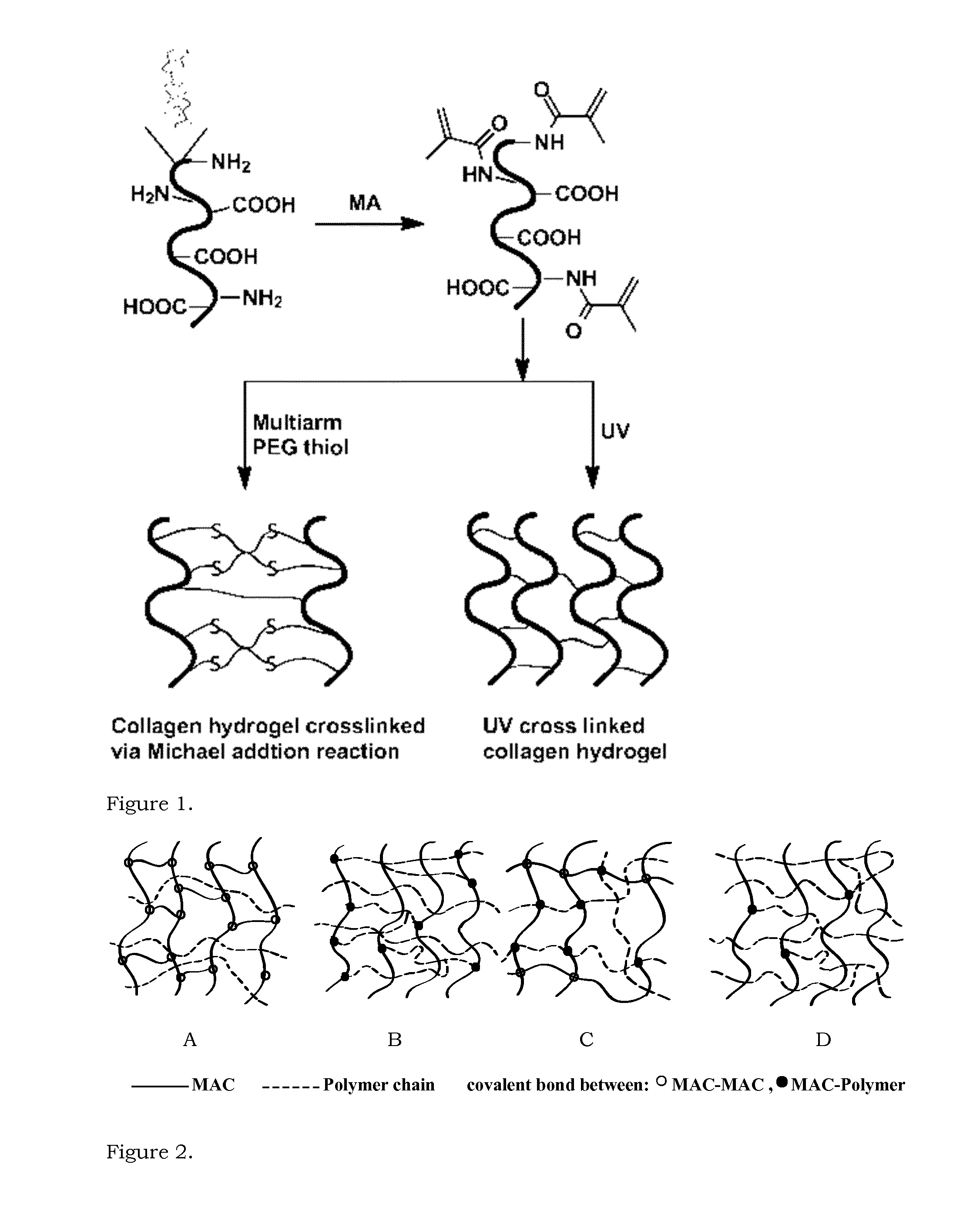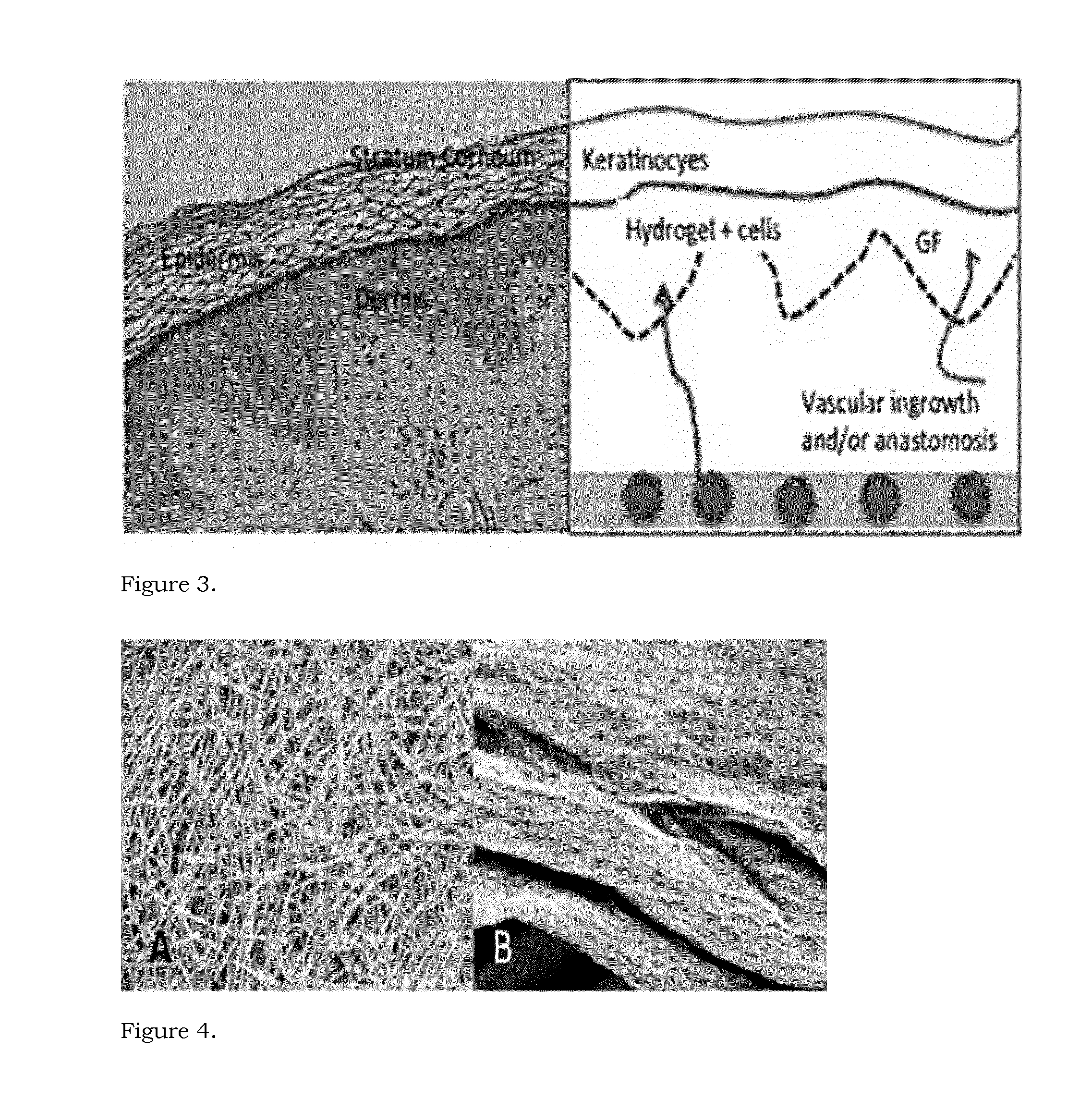Transparent hydrogel and method of making the same from functionalized natural polymers
- Summary
- Abstract
- Description
- Claims
- Application Information
AI Technical Summary
Benefits of technology
Problems solved by technology
Method used
Image
Examples
example 1
Hydrogel of MAC and PEG-SH
[0083]A hydrogel from the Michael addition reaction was prepared by mixing 0.5 mL of 10 wt % MAC with a 4-arm PEG thiol using a three way syringe system. The PEG thiol was dissolved in water and added to get the overall concentration of methacrylated collagen of 5%. The solution from the syringe was casted between two glass slides / molds with spacers of desired thickness and stored under humid conditions overnight. A stiff hydrogel was obtained, as shown in FIG. 5. This result confirms the proof-of-concept that a stiff hydrogel can be prepared by the overnight reaction of MAC with a 4 arm PEG thiol. The absence of UV light and by-products makes this hydrogel promising for corneal application. Such features make this hydrogel suitable for encapsulation and delivery of stromal stem cells in cases of HSV conditions, when the patient lacks the pool of the stem cells, thus making conventional regenerative approaches impractical.
example 2
Methacrylation of Collagen
[0084]0.5% collagen solution in 1×PBS was prepared (pH 6.5-6.7). The pH was raised to 10 using NaOH at −4° C. Methacrylic anhydride (10:1 molar ratio w.r.t. amine groups in collagen) was added drop wise to collagen solution in 3 batches and the solution was stirred vigorously for 4 hours. The reaction mixture was dialyzed for 4 days against distilled water at room temperature.
[0085]The results from circular dichroism and NMR are found in FIGS. 6 and 7.
[0086]The circular dichroism spectrum of MAC at 1% by weight concentration in Milli-Q water, at room temperature, showed maximum at 225 nm and a minimum near 200 nm at pH 7.4 and pH 10 which is indicative of collagen triple helices. The triple helical propensity is higher at high pH.
[0087]HNMR spectra of MAC at 1% by weight concentration in D2O, at room temperature showed two new peaks between 5-6 ppm, characteristic for two acrylic protons of methacrylic functionality.
[0088]The inventors found that transparen...
example 3
Preparation of CMP Hydrogel
[0092]T-piece mixing system was used to make hydrogels with CMP, which was previously described. For making the hydrogel 500 mg of 12% (w / w) CMP was mixed with 300 μl of water. Calculated volumes of NHS and then EDC were added to the syringe mixing system. Depending on the molar equivalent ratio of EDC to amine of CMP, 3 different types of hydrogel were made; CMP-NH2:EDC=1:0.5, CMP-NH2:EDC=1:1 and CMP-NH2:EDC=1:2. The molar ratio of EDC:NHS was 1:1. The stock solution concentrations of EDC and NHS were adjusted in such a way that in all different types of hydrogels, dilution factor of CMP remained same. All addition followed by thorough mixing. Table 3 and 4 discloses some results and properties of the obtained hydrogels. Circular dichroism revealed triple helical formation.
TABLE 3Mechanical properties of CMP hydrogels.Young'sFormulationTensile strength / Elongation atModulusCMP:EDC / NHS ratiomax Load (kPa)Break (%)(mPa)1:0.51.47 ± 1.2 67.10 ± 37.200.22 ± 0.0...
PUM
| Property | Measurement | Unit |
|---|---|---|
| Temperature | aaaaa | aaaaa |
| Temperature | aaaaa | aaaaa |
| Temperature | aaaaa | aaaaa |
Abstract
Description
Claims
Application Information
 Login to View More
Login to View More - R&D
- Intellectual Property
- Life Sciences
- Materials
- Tech Scout
- Unparalleled Data Quality
- Higher Quality Content
- 60% Fewer Hallucinations
Browse by: Latest US Patents, China's latest patents, Technical Efficacy Thesaurus, Application Domain, Technology Topic, Popular Technical Reports.
© 2025 PatSnap. All rights reserved.Legal|Privacy policy|Modern Slavery Act Transparency Statement|Sitemap|About US| Contact US: help@patsnap.com



